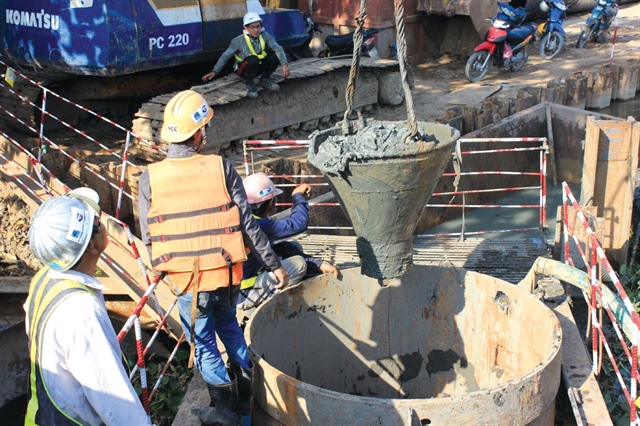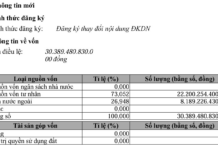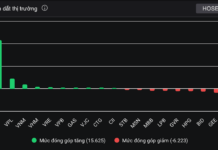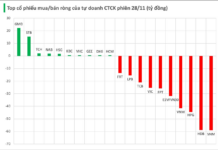
Labor prices set by local authorities range from about 200,000-300,000 VND per day, while in reality, the market rate for unskilled labor is already 400,000-500,000 VND per day. Photo: T.L |
Mr. Nguyen Tuan Anh made these remarks at a conference organized by the Ministry of Construction and the Ministry of Transport earlier this week to implement Official Dispatch No. 02/CD-TTg of the Government, which requires focusing on resolving difficulties and obstacles related to construction norms, prices; exploitation, supply of construction materials for key transportation projects, important national projects.
The conference was co-chaired and connected online by Deputy Minister of Construction Bui Hong Minh and Deputy Minister of Transport Le Anh Tuan with 46 localities having key transportation projects, important national projects.
Despite being interrupted several times because his speech exceeded the permitted time, Mr. Phung Tien Thanh, Vice Chairman of the Board of Directors of Deo Ca Group, still “requested to speak” because there are many pressing issues, the contractors have made numerous suggestions for many months but have not yet received any results.
Mr. Thanh stated that the current construction norms are based on Circular No. 12/2021/TT-BXD of the Ministry of Construction issued on August 31, 2021. However, many norms do not reflect the actual waste on construction sites, and the new norms tend to reduce compared to the old ones; at the same time, there are still many missing norms. For example, for the construction of stone embankments, the previous norm was 1.42 cubic meters of stone/m3 of completed embankment, but according to the aforementioned Circular 12, the material waste is reduced to only 1.34 cubic meters of stone/m3 of completed embankment. Therefore, the amount of material waste to complete 1 cubic meter of stone embankment has decreased, while the waste in construction according to the norm remains unchanged. Alternatively, the use of stone for pavement, which is being applied in many key projects, has not been regulated regarding the stone filling norms and compaction factors.
Labor prices set by local authorities are also inadequate. “According to the prices set by localities, the labor prices range from about 200,000-300,000 VND per day. In reality, the market rate for unskilled labor is already 400,000-500,000 VND per day. On days off and public holidays, the labor prices should be doubled or tripled, but there is no standard, no estimate for that,” a representative of Deo Ca Group said.
|
The ministries – especially the Ministry of Construction, the Ministry of Transport, and localities (especially provinces and cities with key projects, important transportation works) – must quickly resolve current obstacles regarding construction norms. If businesses continue to incur losses, it will affect the disbursement progress of infrastructure projects. |
In addition, the current norms also lack many aspects, which creates difficulties in application when making estimates and assessments, acceptance, payment, and final settlement. “For example, in the Quang Ngai – Hoai nhon project we are currently implementing, the item of filling earth and stone embankments does not have a standard for application. Therefore, the contractor must temporarily settle according to the earth fill price – which greatly affects the capital recovery and finance of the contractor. We have reviewed the current projects and sent a document to the Department of Construction Investment Management, the Ministry of Transport, proposing the addition of 30 new norms,” he said.
Sharing the difficulties of Deo Ca, Mr. Nguyen Tuan Anh, Deputy General Director of Truong Son Construction Corporation, emphasized the shortcomings in the construction norms for stone embankments, “which have been a very pressing issue, affecting the economic efficiency of the contractors”. Along with that, he added the difficulties in estimating material transportation costs. Specifically, during the post-verification process, inspection agencies, and checks require the lowest-cost type of vehicle to adjust the estimate (using large-tonnage trucks, making fewer trips – PV). However, in reality, due to land constraints, most projects cannot be transported internally following the design profile but have to use detours, local roads – which require low-tonnage trucks of only 8-10 tons. Thus, the difference in transportation costs with 20-ton trucks is significant.
Especially, according to the feedback at the conference, in the past period, contractors have encountered many difficulties in implementing licensing procedures for mining exploitation under special mechanisms. The procedures from preparation to the issuance of mining permits took about eight months, due to the lack of clear guidance from the beginning, different understandings and applications among localities based on safety and caution, leading to prolonged procedures. “The project takes two to three years to complete due to construction on weak land, which requires 8-14 months of consolidation period. However, the annual material mining procedures have not been completed. After signing the contract, the contractor must proceed with the construction, but if the mining progress is delayed, the project schedule cannot be guaranteed,” Mr. Nguyen Tuan Anh said.
Moreover, the biggest problem is determining the material prices at the mines under specific mechanisms. Currently, many cost items for miners directly implementing material mining have not been specifically guided for monitoring and acceptance, such as supervision, appraisal, approval of construction plans, and mining exploitation; compensation for trees, flowers, assets on the land; excavation of cover layers; access roads to mines; bomb clearance…
Especially, the contractor must negotiate and compensate for land and assets on mining land with owners and residents, which is very difficult and time-consuming. “How much is the cost of compensating for mining? We have approved that price, but has the legal basis been fulfilled? We estimate the compensation price for the previous mines at 400 million VND per hectare, but in reality, compensation may amount to 1.2-1.4 billion VND per hectare,” a representative of Truong Son Construction Corporation shared and also believed that it would be better if the state management agencies had general instructions for contractors to apply.
Also due to difficulties in determining the prices of materials at mines, investors and project management committees only calculate 70% of the contract price for investors. This makes it difficult for the contractors in terms of capital sources for implementation and also carries inherent risks in terms of post-verification because these are all projects for specific contractors.
To quickly solve these issues, Deputy Minister of Construction Bui Hong Minh proposed the establishment of a working group between the Ministry of Construction and the Ministry of Transport. The working group will be responsible for reviewing missing norms, inappropriate norms, non-updated norms, and classify which norms fall under the Ministry of Construction and which fall under the Ministry of Transport for supplementation, adjustment, and new issuance. It is planned that in the first quarter of 2024, the Ministry of Construction will supplement 318 norms according to its jurisdiction. Along with that, continue to review, supplement and adjust missing or inappropriate norms. Also, in the first quarter of 2024, the Ministry of Transport will issue new and supplemented norms for 547 project estimates.
According to Decree No. 10/2021/ND-CP on the management of construction investment costs (Article 43), specialized construction management ministries and provincial People’s Committees issue construction norms for specialized tasks on a periodic basis and submit new construction norms and adjusted norms to the Ministry of Construction for monitoring and management. Therefore, the ministries – especially the Ministry of Construction, the Ministry of Transport, and localities (especially provinces and cities with key projects, important transportation works) – must quickly resolve current obstacles regarding construction norms. If businesses continue to incur losses, it will affect the disbursement progress of infrastructure projects and slow down the economic recovery of the country.
An Nhien




































